
Having lived most of my life in North America, I can report that we love caffeine here. It’s kind of a really big thing. Mention the coveted stimulant caffeine and coffee is most likely the first plant to come to mind. For some it may conjure up green or black tea, or even kola nut, yerba mate or yuahusa.
There’s an elephant in the room here, all of these caffeine containing plant come from far away, sometimes across the globe. The negative social and ecological implications associated with our morning cuppa are often overlooked. Even if we’re talking fair trade organic (which is a big step in the right direction) the products are still shipped from afar. Why has a native and hardy shrub that boasts high levels of caffeine fallen into obscurity? Good question. Read on to find out why.
We had heard about this plant years ago, but just this past year we were reading Peterson’s Field guide to Medicinal Plants and Herbs by James Duke and Steven Foster, our interest was further piqued.
A caffeine-containing shrub that is growing only a few hours south of us?
Whaaaat? You have our attention!
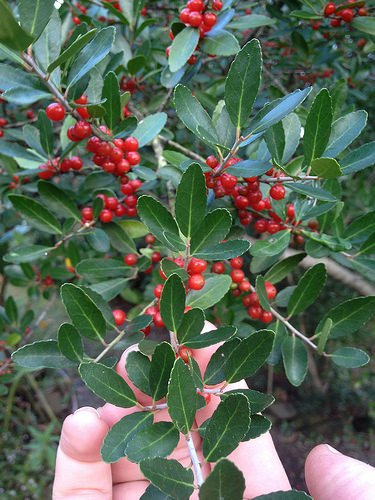
(source)
I’ve been drinking mate on and off for over a decade and was very intrigued by the potential for harvesting something similar close to home.
The shrub is most commonly known as yaupon (yo-pawn) holly and belongs to the ilex genus. Some of you may be more familiar with yaupon’s southern cousin, yerba mate (ilex paraguayensis). Yerba mate’s range is much further south (Argentina, Paraguay, Uruguay and parts of Brazil), but provides a very similar brew and flavor to yaupon. What I love about mate is the sustained energy it provides (without the jitters or crash associated with coffee) and the wide range of vitamins and minerals it contains. Not to mention other xantines like theobromine, but we’ll save that for part 2.
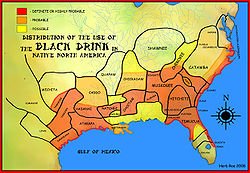
(source)
Caffeine growing wild in marginal and drought-ridden lands
Yaupon’s range includes a large part of the southern United States and a small area in Chiapas, Mexico. Yaupon is a tough plant that boasts resiliency, allowing it to survive in poor soils and thrive in hot, dry and even salty conditions. This means that a lot of marginal lands in the Southern USA are replete with an untapped resource, and potential for a sustainable tea industry. In parts of Texas people consider it a veritable weed! This could be a source of caffeine grown at home in zones 6b or higher and it could easily become a small-scale commercial organic farm crop.
Digging deeper an intriguing history revealed itself...
What shocked us most is that Yaupon wasn’t more popular. After all, North Americans love caffeine and there is a history of entrepreneurship sometimes verging on exploitation. So what gives?
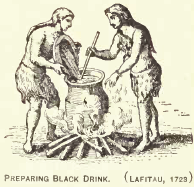
(Making Black Drink - source)
The indigenous people most certainly drank the tea. Beautiful artifacts associated with yaupon were found well outside of its natural habitat, suggesting its widespread use, trade, and consumption. Early written accounts mention the frequent consumption of the “black drink” (another common name), brewed from the toasted yaupon leaves. When settlers arrived, they too learned of the stimulating properties of a tea made from yaupon leaves and took up the practice of consuming it.
Here’s where the plot thicken and history becomes suspect. The settlers’ accounts of native ceremonies grossly misrepresented the cultures that was being observed (no surprise there). During certain ceremonies, in particular those involved with purification, a strong brew of yaupon was consumed. The participants would purge themselves (a nice way to say vomit) as part of the cleansing process. What is not clear is what other plants were consumed and used specifically as an emetic (to induce vomiting). Yaupon does not induce vomiting, but was perhaps used as a sacred plant in these cleansing rituals, but this reality couldn't withhold the fate that was to befall this wondrous plant.
Worst botanical name EVER!
One theory suggests that yaupon fell out of favor as the result of intentional slander and sabotage. Remember the bit about vomiting? One idea is that those who had interests in seeing the Asian tea trade thrive (mostly in the form of fermented black tea from the camellia sinensis plant --taxable by the British, I might add) hired a botanist to create the most despicable name for a wonderful plant. As botany classification works, if you describe a new species, you get to name it. Yaupon was now botanically know as ilex vomitoria, erroneously associating yaupon with vomiting.
We wonder if it is this name that carries the stigma today?
In one study college students were given taste of mate and yaupon side by side. In a blind sampling, they chose the yaupon over the very popular yerba mate until told what its name was. How can we help shake this horrible name? (source)
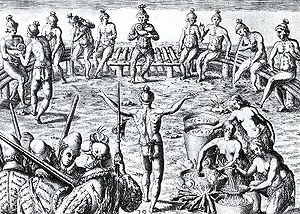
(Historic Preparation for Communal Consumption of the Black Drink - source)
This powerfully suggestive name lessened the public appeal, giving the Asian tea importers a competitive edge. What was a readily available and widely accepted tea was given a very bad name, and a reputation that followed it like the plague.
There was hope for a future industry
During the civil war as with all wars, soldiers have needs. Stimulation was one of those needs. To meet the needs of a cash strapped nation, there was a budding industry that arose out of the need give the soldiers a buzz. Small processing plants were set up to dry, roast and pack the leaves. The leaves of yaupon like yerba mate contain a thin layer of wax, which complicates drying slightly. Toasting was the most common method for circumventing this issue. This was the max of yaupon's hayday.
Historical information is sparse as to why the industry never took off in earnest, but perhaps the book Black Drink: A Native American Tea by Charles M. Hudson offers more info.
Today there are a few companies reviving the lost tea plant and recreating a culture of yaupon.
Yaupon has received some press attention in progressive area like Austin, TX and Asheville, NC, but on the whole remains mostly unknown. In my research meanderings, I came across a few companies selling yaupon tea, in a variety of roasts and blends. I was very excited to see this and contacted a few of them, soon finding that all the leaves are wild harvested. It seems crazy that no one would have attempted cultivation of this plant as it thrives in harsh conditions and responds to nitrogen rich environment with more profuse and vigorous leaf growth.
In calling dozen of nurseries and spending hours searching online, I still haven’t found any nurseries that propagate wild yaupon seedlings. I’ve only come across named cultivars for ornamental plantings (which contain lower amounts of caffeine). Most of the nurseries didn’t even know they were growing a plant that contained a delicious caffeine rich beverage. I wouldn't be surprised if many commercially landscaped homes in the Southeast have yaupon holly in their yard.
(Youpon holly dwarf variety for landscaping. We have bought some of these for our landscape, but want a wild version as it boasts higher caffeine levels in each leaf - source)
The search continues…
Onwards as always we tread... After being somewhat discouraged, I realized the incredible opportunity that lay before us. We could be the ones to experiment with this wild species. This was an opportunity for us to practice “tending the wild” as the renowned wild food expert Sam Thayer writes so eloquently about in the book by that title.
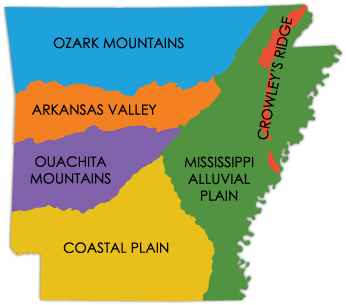
(source)
Join us as we journey south in coming weeks into the Ouchita Forest in search of North America's Forgotten Caffeine Plant. In Part 2 the story continues in our journey south to visit yaupon in the wild and try our hand at harvesting leaves and seeds. We will also explore the health benefits and medicinal potential of the yaupon holly.

